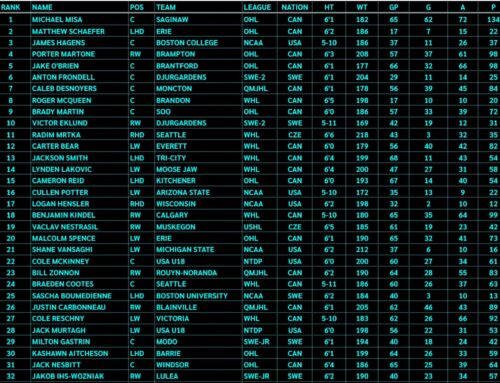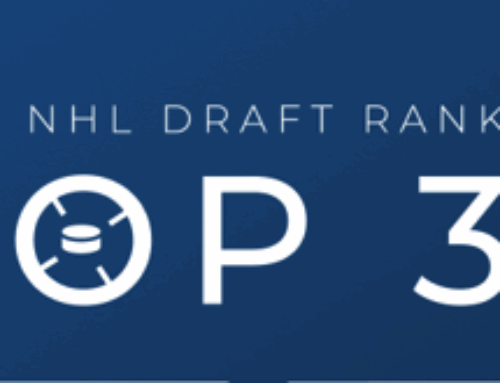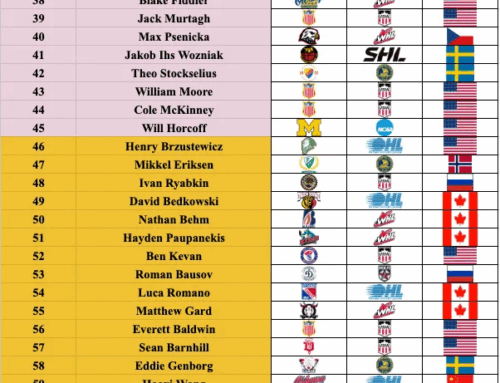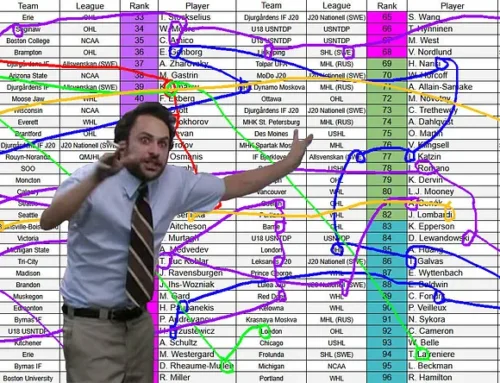WHL Report: Three of the League’s Best Defensemen — Olen Zellweger, Carson Lambos, & Kaiden Guhle
Sebastian High
2022-05-07
The WHL has been consistently producing good NHL defensemen, ranging from Ivan Provorov to Shea Theodore. This trend is continuing with the 2022 Draft Class, with Denton Mateychuk, Kevin Korchinski, and Owen Pickering all being likely first-round selections come July 7. However, today’s focus will be drawn to three WHL defensemen that have already been drafted. The trio may play very different games from one another, but the three left-shot defensemen have dominated the league in their individual ways this season.
Olen Zellweger — Everett Silvertips (Selected #34 Overall by Anaheim in 2021)
Olen Zellweger was the WHL’s most talented and electrifying defender this season, and there was no close second. His combination of skating ability, speed, four-way mobility, vision, dynamism, and playmaking made him a constant threat. Not a shift went by where he faded into the background. His high-octane style of play certainly brings the risk of turnovers and odd-man rushes the other way, but the pros far outweighed the cons in 2021/22, even more so than they had in his draft year. Calling Zellweger’s production this season historic is accurate, as well. His 78 points in 55 games (1.42 pts/g) as a defenseman – and in the WHL of all CHL leagues – surpasses the points per game totals of all defensemen since the 1994/95 season, and that’s without even filtering out for minimum games played.
This ridiculous production, which includes 14 goals, is enough to make Zellweger top the PNHLe ratings of all drafted prospects in fellow Dobber writer Mason Black’s production equivalency model. In short, this means that Zellweger’s production was more impressive than that of every single other drafted prospect outside the NHL, accounting for variables such as age, league, and position. Zellweger had a tremendous season and that form has translated to the playoffs, in which he has put up seven points in five games.
Pair Zellweger’s offensive skill with his ability to suffocate plays when defending transition, aided by his high-end ability to match the footwork of the oncoming rusher which allows him to play a tight gap and push play to the perimeter, and you have yourself a defenseman with an extremely high ceiling. The Anaheim Ducks made a tremendous selection at the start of the second round last year and his development this year has made it look even better. The left-handed defenseman has the all-around ability, processing speed, and dynamism to become a top-pairing guy if his development continues on its current trajectory. Fantasy users should jump on him as quickly as possible if he is available, and could reap the results as early as 2023/24.
Carson Lambos — Winnipeg Ice (Selected #26 Overall by Minnesota in 2021)
Lambos went in the same range as Zellweger, and while he may not be getting nearly as much hype as his counterpart, the Minnesota Wild’s tendency to draft high-value players with significant upside continues with this pick (which came right after the heist they pulled to get Jesper Wallstedt at #20). Lambos played through injury last season and saw his draft stock plummet as a result; once regarded as a top-5 talent, he wasn’t even unanimously deemed first-round talent on draft day. While his performances have been blurred by playing on a team as dominant as the Ice this season, Lambos has been terrific as their number 1 blue-liner.
What makes Lambos special is his well-roundedness with a few elite skills. He is a strong and mobile skater, which he retains while skating forward and backward. He gains zone exits at a high rate and has a knack for beating the F1, which he does with his deceptiveness, often employing a quick shoulder fake, reading his opponent’s feet, waiting for them to commit with a crossover and then quickly shifting the other way. While Lambos doesn’t often carry the puck through the neutral zone and into the offensive zone, he regularly makes an accurate pass to a teammate to gain the zone. In the offensive zone, Lambos lacks the aggressiveness of the two other players profiled in this piece but possesses a cannon of a shot and great playmaking ability from the blueline. His 10 goals and 47 points in 51 games as a D+1 blue-liner reflect this offensive ability and put him in third on the board of D+1 defensive point leaders in the WHL.
On the defensive side of things, Lambos is utterly reliable. He kills plays with an active stick, decent gap control, and a skill for forcing play away from the slot. Whereas Zellweger is an offensive defenseman with some great defensive qualities, Lambos is an intelligent all-rounder with great reads and foresight in his game, which help him project as a future second-pairing defenseman in the NHL with upside on both special teams units. Lambos has an underrated chance of developing into a Jeff Petry style of player, defined by solid skating ability, a heavy shot, strength in zone exits and the upside to hit 40 points, so astute fantasy managers should consider pouncing on him before he gets the hype he deserves. He might still be two or three years out from the NHL, however, so patience would be required.
Kaiden Guhle — Edmonton Oil Kings (Selected #16 Overall by Montreal in 2020)
Guhle is the oldest of the three profiled players and is the most likely to play in the NHL next season. He likely will see NHL action in 2022-2023, but its extent is a question mark, depending on his training camp, the performances of other rookies such as Jordan Harris and Justin Barron, and the look of the remainder of the Habs’ defensive corps, including whether or not Jeff Petry is traded and whether he is replaced.
Guhle may lack the dynamism of Olen Zellweger and the point shot of Carson Lambos, but he nonetheless makes for an easy middle-pairing projection, with the potential to become a #2 in the right circumstances and if his development takes an upswing upon his entry into professional hockey. This is due to his elite defensive impact at the WHL level, his skating ability, and his built-up willingness and skill in jumping up into the play offensively. Guhle’s physicality is dominant, but he doesn’t (usually) chase hits. Rather, he is a brick wall in transition defense, forcing turnovers upon the opponents attempting to gain the zone on his side of the ice at a ridiculous rate.
Guhle’s biggest weakness comes in the breakout. When he is pressured, he can often resort to a thoughtless clear or pass directly to the opposing team. The frequency of this has been reduced significantly since his draft year, but it is still an area he needs to concentrate on improving. I am hopeful that he will be able to do so because his excellent scanning habits, especially in the defensive zone, allow him to make plays with foresight. If he can apply this to the neutral zone and to moments when he has less time to make a decision, he could become a true positive player in offensive transition.
Since his draft year, Guhle has also added some offensive skills. Where he used to be a volume shooter from low danger areas, he now jumps up into the offensive zone, exploiting soft ice and firing off a strong wrist shot or sliding a pass to a teammate against the grain. While he will never be labelled an offensive defenseman, Guhle has added enough tools to his arsenal to be deemed a two-way rather than purely defensive blue-liner. This newly-developed offensive awareness has helped him score 7 goals and 40 points in 42 games this year. Guhle should especially be picked up in fantasy leagues with extra value placed on hits, but any fantasy manager would get good value with a nearly surefire second-pairing defenseman who could assume the role as early as this upcoming season.
– Sebastian High
Feel free to follow me on Twitter (@high_sebastian) for prospect analyses, 2022 NHL Draft coverage, and intermittent rants about my Montreal Canadiens.






